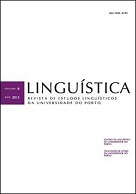Les verbes à objets cognats en portugais européen: quelques réflexions sur la conversion et la génération de mots
Resumo
Le texte analyse les verbes à objets cognats en Portugais Européen et propose une analyse de ce phénomène dans le cadre de la Morphologie Distribuée et de quelques idées du Programme Minimaliste. Dans cet article nous développons uniquement l’analyse syntaxique des constructions du type chorar um choro... [pleurer un pleur…] et cantar uma cantiga [chanter une chanson]. Puisqu’une théorie lexicaliste comme celle développée par Hale & Keyser (1993; 2002) ne parvient pas à résoudre toutes les questions soulevées par les différents types de constructions en PE, nous essayerons une analyse qui concilie les contributions de Haugen (2009), à propos des objets cognats, Marantz (1993) et Alexiadou (2001, 2006), sur l’existence de têtes fonctionnelles verbales, et (Chomsky 1995), sur l’idée de mouvement par copie.
Referências
Alexiadou, A. 2001. Functional Structure in Nominals: Nominalization and Ergativity, Amsterdam: John Benjamins.
Alexiadou, A. 2006. On the morphosyntax of (anti-)causative verbs. Disponible dans: http://ifla.uni-stuttgart.de/files/artemis-anitaworkpap-revised3.pdf (28/05/2013).
Bosque, I. & Gutierrez-Rexach, J. 2009. Fundamientos de Sintaxis Formal, Madrid: Akal. Choupina, C. 2013. Contributos para uma análise sintática dos objetos cognatos em PE. In Studia Romanica Posnaniensia, Adam Mickiewiez University Press: Poznan, vol. XL/1, 2013, 59-79. ISBN 978-83-232-2542-3.
Chomsky, N. 1995. The Minimalist Program. Cambridge MA: The MIT Press.
Gallego, A. 2012. A note on cognate objects: cognation as doubling. In Bentzen, K. & Fábregas, A. (Eds.) Nordlyd 39.1: 95-112, University of Tromso. Disponible dans: http://www.ub.uit.no/baser/nordlyd/ (11/05/2012).
Hale, K. & Keyser, S. J. 1993. On Argument Structure and the Lexical Expression of Syntactic Relations. In Hale, K. & Keyser, S.J. (Eds.) The View From Building 20: Essays in Linguistics in honor of Sylvain Bromberger. Cambridge. Mass., MIT Press, 53-109.
Hale, K. & Keyser, S.J. 2002. Prolegomenon to a theory of argument structure. Cambrige, Mass., MIT Press.
Halle, M. & Marantz, A. 1993. Distributed morphology and the pieces of inflection. The View from Building 20. In K. Hale & S.J. Keyser (Eds.), 111–176. Cambridge, Mass.: MIT Press.
Harley, H. & Noyer, R. 1999. State-of-the-Article: Distributed Morphology. Glot International 4.4, pp 3-9.
Haugen, J. D. 2009. Hyponymous objects and Late Insertion. In Lingua 119, 242-262. Horita, yuku 1996. English Cognate Object Constructions and Their Transitivity. In English Linguistics 13, 221-247.
Kitahara, Ken-ichi 2006. On the Form and Meaning of Cognate Object Constructions in English: A Construction Grammar Approach. In Tsukuba English Studies, vol. 25, 125-126. Disponible dans: http://www.tulips.tsukuba.ac.jp/mylimedio/dl/page.do?issueid=867952&tocid=100066195&page=125-126 (27/05/2012)
Marantz, A. 1993. Implications of Asymmetries in Double Object Constructions. In Mchombo, S. A. (Eds.) Theoretical aspects of Bantu Grammar, vol. 1. Stanford: CSLI Publications, 113-150.
Pustejovsky, J. 1998. The Generative Lexicon. Cambridge, Mass: The MIT Press. Pylkkänen, L. 2002. Introducing Arguments. Ph. D. Dissertation, MIT. Pylkkänen, L. 2008. Introducing Arguments. Cambridge: MIT Press.
Ramchand, G. 2008. Verb Meaning and the Lexicon: a first phase syntax, Cambridge University Press.
Real-Puigdollers, C. 2008. The Nature of Cognate Objects. A Syntactic Approach. In Proceedings ConSOLE XVI, pp. 157–178. Disponible dans: http://media.leidenuniv. nl/legacy/console16-real-puigdollers.pdf (27/05/2011).
Rodrigues, A. S. 2001. A construção de postverbais em português. Porto: Granito Editores e Livreiros.
Siddiqi, D. 2009. Syntax within the Word. Economy, allomorphy, and argument selection in distributed morphology, Linguistik aktuell/Linguistics Today: JB.
Silva, M. L. 2010. As construções com objeto cognato em Português – análise e esboço de modelagem sociocognitiva. Disponible dans: http://marcelolopesdasilva.com.br/index.php/textosdoautor/doc_details/12-2010b-as-construcoes-com-objeto-cognato-em-portugues-analise-e-esboco-de-modelagem-sociocognitiva.html (27/05/2012).
Downloads
Publicado
Edição
Secção
Licença
Direitos de Autor (c) 2017 Linguística Revista de Estudos Linguísticos da Universidade do Porto

Este trabalho encontra-se publicado com a Creative Commons Atribuição-NãoComercial 4.0.



